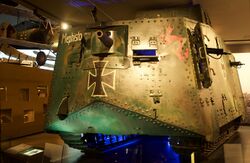Engineering:Pike nose

A pike nose (from Russian: щучий нос) is a configuration of vehicle armour in which an armoured vehicle's frontal armour consists of three angular plates put together to form a cone-like shape, similar to the nose of a pike, from which the name stems.[1][2] Often welded, it can also be cast.[2] The design allows for very effective frontal angling of the armour plates, increasing protection from the front.[1][2]
The pike nose have appeared on armoured vehicles since World War I, but the design first gained popularity following World War II, with heavy tank designs such as the Soviet IS-3.[2] Following the obsolescence of heavy tanks, however, the design have become rare in modern times, only rarely appearing on light vehicles and the like.[2]
History

By technicality, the first tank to feature a pike nose was the German Sturmpanzerwagen A7V of World War I. The sloping of its frontal armour plates was, however, subtle and not very "pike like". The first vehicle to feature a traditional pike nose were some of the concepts for the British Valiant tank of the early 1940s.[2] These concepts were later altered to feature a strange cast dome on the upper front hull, which came to stay for the single prototype produced.[2]
The first production tank to feature a conventional pike nose was the Soviet IS-3, which entered service in 1945 at the very end of WWII.[2] The Soviet pike nose concept initially started with a revamped version of the IS-2 heavy tank from late 1944, known as the IS-2U, which eventually evolved into the IS-3.[2] The IS-3 was arguably the most heavily protected tank of its time and came to popularize the concept of the pike nose to the rest of the world. The Soviets came to use the pike nose on several tank projects going forward, such as the IS-7 and IS-8 heavy tank projects, the latter entering service as the T-10, but also other armour projects, such as the Object 268 heavy assault gun.[citation needed]
In the post-war western world, the pike nose saw use on several tank projects. Most designs featured a welded pike nose like the Soviet IS-3 design, such as the French Lorraine 40t medium tank project and AMX-50 heavy tank project, the Swedish EMIL/KRV heavy tank project and the early British FV4201 Chieftain project. The Americans, however, favoured cast hull designs and introduced cast pike noses with the advent of the M48 Patton medium tank and M103 heavy tank. This design was soon picked up by the French and Biritish, leading to cast noses for their ongoing tank projects, the French producing the AMX-50 Surbaissé variant with a proper cast pike nose and the British changing the final FV4201 Chieftain design to feature something similar to a cast pike nose, although flattened in the center.[2]
Due to improved penetration performance against angular armour from modern anti-tank ammunition, however, the pike nose solution soon fell into obsolescence for heavy armour.[2] The pike nose does however still remain relevant for lightly armoured vehicle, whom only need protection against small arms and the like. A shallow pike nose was featured on the Swedish pansarbandvagn 302 (pbv 302) infantry fighting vehicle of the 1960s and a subtle pike nose was featured on the Swedish infanterikanonvagn 91 (ikv 91) light assault gun of the 1970s.[citation needed]
List of tanks featuring pike nose
- 1918 –
 Sturmpanzerwagen A7V
Sturmpanzerwagen A7V - 1943 –
 Tank, Infantry, Valiant (A38)
Tank, Infantry, Valiant (A38) - 1945 –
 IS-3
IS-3 - 1946 –
 IS-7
IS-7 - 1950 –
 KW30/50 (Panzer 58 concept)
KW30/50 (Panzer 58 concept) - 1952 –
 M48 Patton (cast hull)
M48 Patton (cast hull) - 1952 –
 Lorraine 40t
Lorraine 40t - 1954 –
 IS-8/T-10
IS-8/T-10 - 1955 –
 EMIL/KRV
EMIL/KRV - 1955 –
 AMX-50 Surblindé
AMX-50 Surblindé - 1956 –
 AMX-50 Surbaissé (cast hull)
AMX-50 Surbaissé (cast hull) - 1956 –
 Object 268
Object 268 - 1957 –
 M103 (cast hull)
M103 (cast hull) - 1957 –
 FV4201 Chieftain (early concepts)
FV4201 Chieftain (early concepts) - 1959 –
 Object 757
Object 757 - 1964 –
 WZ-111 Heavy Tank
WZ-111 Heavy Tank - 1966 –
 Pansarbandvagn 302
Pansarbandvagn 302 - 1975 –
 Infanterikanonvagn 91
Infanterikanonvagn 91
Gallery
Valiant tank prototype with a cast dome on the upper pike nose.
An IS-7 prototype during winter trials in 1948.
References
Notes
 |








